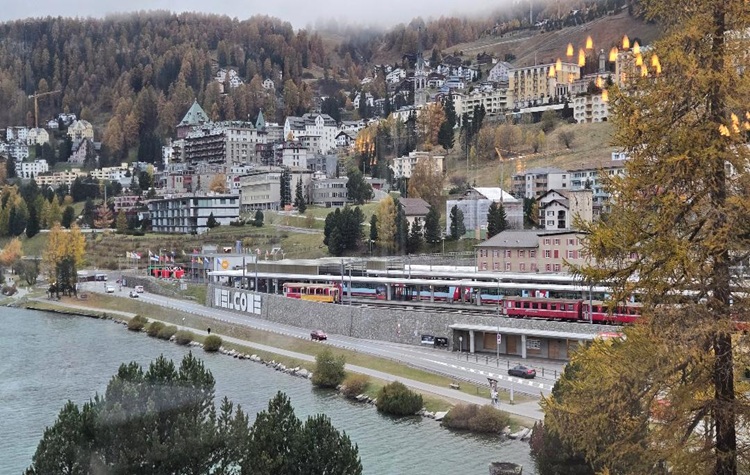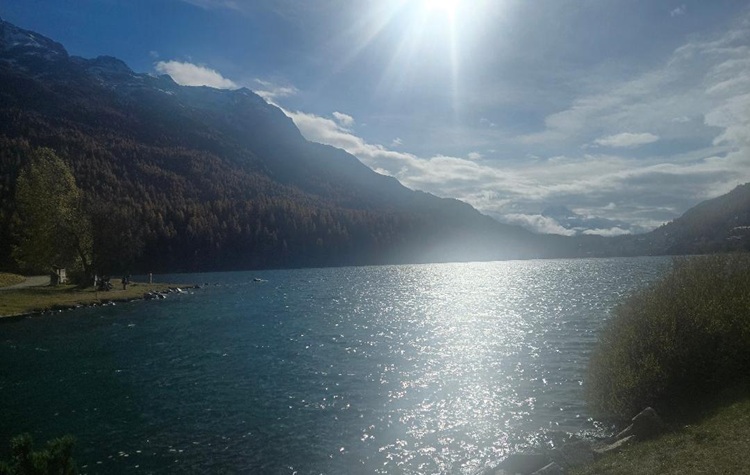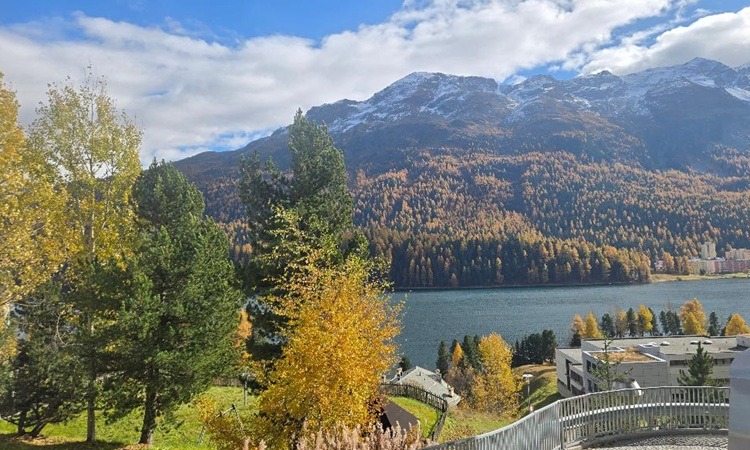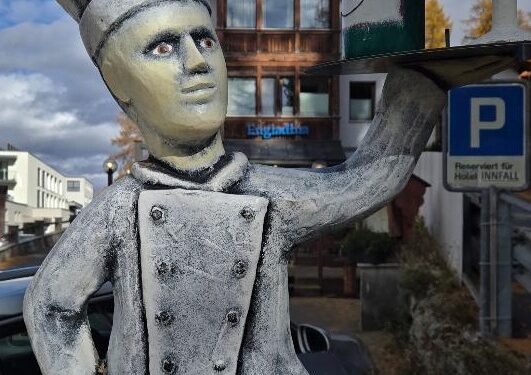Nestled high in the Swiss Alps, St. Moritz is a destination that conjures images of glittering ski slopes, five-star hotels, and the quiet elegance of an alpine paradise. The sparkling lake, snow-capped peaks, and sun-drenched valleys have drawn travelers for over a century, seeking both leisure and the restorative powers of its famous mineral springs. Yet beyond the glimmering facades of luxury resorts and chic boutiques lies a history less known—a story that intertwines Jewish heritage, resilience, and the enduring human spirit with the breathtaking landscapes of the Engadin Valley. For Jewish travelers, St. Moritz is not merely a playground for winter sports; it is a place where memory, culture, and a touch of the extraordinary converge.
As Susi Wiprachtig, coordinator of St. Moritz Guides, tells the New York Jewish Travel Guide, “Most visitors see the glamorous side of St. Moritz—the hotels, the lake, the slopes—but the town has stories that whisper beneath the surface. Every corner has a memory, if you know where to look.”

A Hidden Jewish History in the Alps
While St. Moritz is synonymous with luxury and winter sports, its Jewish history is quietly woven into its story. Jewish travelers and families, particularly from Central Europe, began arriving in the early 20th century, drawn by the purity of the air, the promise of restorative waters, and the town’s discretion—a valued feature during times of social tension. Over the decades, St. Moritz became more than a resort destination; it evolved into a welcoming haven where Jewish families could come together while enjoying the pleasures of Alpine leisure. The Jewish presence in St. Moritz and the surrounding Engadin Valley extended beyond tourism. During the harrowing years of World War II, Switzerland served as a refuge for Jewish children fleeing Nazi-occupied Europe. Some of these children arrived through initiatives like the Kindertransport or the Swiss “300 Children Campaign,” which sought to rescue and shelter Jewish minors. Historical accounts indicate that a children’s home in nearby Celerina hosted some of these young refugees, providing a safe harbor amid uncertain times. Although the details are not always clear, the influence of these efforts remains part of the region’s cultural memory.
From Glamour to Refuge: The Jewish Story of St. Moritz
In its modern image, St. Moritz dazzles with glitzy ski resorts, designer boutiques, and the refined elegance of its grand hotels. But beneath this glittering surface lies a history of resilience, community, and cultural preservation. The town became a quiet refuge for Jewish visitors during Europe’s darkest periods—a place where families could enjoy both leisure and safety.
An emblematic example of this intersection of luxury and heritage was the Hotel Edelweiss, which became a central hub for the Jewish community. Unlike other establishments, the Edelweiss offered kosher meals, a synagogue, and even a mikveh. It became a gathering point for families, rabbis, and Jewish visitors from across Europe. According to past accounts, Leopold, a former owner, noted that there was no hechsher or formal kashrus certification—trust was enough at the time.
What made the Edelweiss truly remarkable, however, was its role in sustaining Jewish life beyond food and ritual. Reports indicate that the hotel also facilitated countless marriages, serving as a hub for shidduchim. Weddings, brissim, and family celebrations unfolded within its walls, embedding the hotel deeply into the fabric of Jewish heritage in the Alps. Though the Edelweiss has since closed, its legacy continues in the ways Jewish visitors engage with St. Moritz today. Families now rent apartments, bring their own kosher supplies, and rely on local supermarkets like Coop and Migros, maintaining traditions and community connections even in the absence of a permanent synagogue.

Seasonal Jewish Life and Modern Kosher Tourism
While St. Moritz does not host a permanent, year-round Orthodox synagogue, it continues to welcome Jewish holidaymakers in style. During selected periods in winter and summer, Starguest brings a full kosher program to the town — with in-house synagogue services, Torah scrolls, and a fully supervised kosher kitchen at the Kempinski Grand Hotel des Bains. According to some community sources, other kosher travel organizers have also run programs in St. Moritz in past seasons, though their appearances can vary from year to year.
Susi Wiprachtig explains, “Yes, when Starguest is operating, there is a functioning synagogue inside the Kempinski—but only during those program weeks. And in some summer seasons, a large hospitality tent is set up near the Signal Bahn station for Israeli and Swiss Orthodox groups. It depends on the year and the organizers.”
Contemporary Jewish Tourism Today.
In recent years, Jewish tourism in St. Moritz has continued to evolve in meaningful ways. While winter programs bring organized minyanim to hotels such as the Kempinski, a summer minyan is also held annually, maintaining a long-standing tradition of seasonal Jewish prayer gatherings in the Engadin Valley. In addition, cultural engagement initiatives have emerged to help strengthen understanding between Jewish visitors and local hosts.
One notable example is the Likrat Public project, launched in 2019, which facilitates dialogue and education to foster respect, awareness, and mutual hospitality. This ongoing effort reflects the continued presence—and continued welcome—of Jewish travelers in St. Moritz today.
Touring St. Moritz: Beyond Ski Slopes
For travelers visiting St. Moritz with Jewish heritage in mind—or simply seeking a richer experience of the town—there are both iconic and hidden gems. Susi Wiprachtig highlights key sites:
- Lake St. Moritz: A shimmering centerpiece of the town, ideal for walks, photography, or just soaking in the alpine scenery.
- The Big Five-Star Hotels (exteriors): Architectural elegance and history can be appreciated even from the outside.
- Leaning Tower of St. Moritz: Slightly more inclined than Pisa’s famous tower, a playful curiosity for visitors.
- Berry Museum: A charming museum celebrating local culture and history, offering insight into St. Moritz’s past through unique exhibits
- Historic Lamp: The site of Switzerland’s first electric light—a small but significant innovation.
- Olympic Bob Track: The oldest natural snow bob track in the world, steeped in winter sporting history.
- Olympic Stadium: Witness to the 1928 and 1948 Winter Games, offering a tangible link to St. Moritz’s role in international athletics.

For visitors seeking off-the-beaten-path attractions, Susi recommends Forum Paracelsus, where one can learn about the origins of tourism in St. Moritz, including the earliest Alpine springs, some dating back to 1411 B.C. Visitors can even taste the historic St. Moritz water, once considered sacred in the 16th century. “If you only have one day in town,” Susi advises, “walk the village and stroll along the lake. It’s the best way to feel the soul of St. Moritz.”
While there are no dedicated Jewish museums or heritage sites in town, visitors can explore the Nietzsche Museum in nearby Sils, which includes photographs of Anne Frank and symbols of world religions—a subtle reminder of the global context in which Jewish life in the Alps has existed.
From Past to Present: Continuity in Heritage
The story of St. Moritz is one of continuity and adaptation. Though the Edelweiss is closed and no permanent synagogue exists, Jewish travelers continue to return, guided by tradition, memory, and the simple desire to connect with a community that has thrived here for generations. The seasonal minyanim, temporary kosher setups, and dedicated travel programs ensure that St. Moritz remains relevant to Jewish tourism.
As Susi notes, “People come for skiing, hiking, or summer relaxation—but they also come to feel a connection, even if it’s quiet and seasonal. There’s history here that can’t be ignored, even amidst the luxury and leisure.”
For Jewish visitors seeking more than the conventional tourist experience, St. Moritz offers a rare combination: the beauty of the Alps, world-class amenities, and a layered heritage that invites reflection and discovery. Whether walking along the lake, exploring the old hotels, or simply enjoying a quiet moment with a piece of nut cake from Hanselmann, travelers can sense the echoes of families, rabbis, and children whose presence has shaped the town’s story.
A Destination for Jewish Travelers
What makes St. Moritz uniquely compelling for Jewish tourism is the intertwining of culture, history, and modern leisure. This Alpine town is not just a winter playground or a summer retreat; it is a living tapestry of Jewish memory. Families who once gathered at the Hotel Edelweiss now return for the seasonal minyanim. Children’s laughter in Celerina’s historical homes is remembered, and the traditions of kosher hospitality continue, adapted for contemporary needs.
St. Moritz is a destination that encourages visitors to look beyond the luxury, to recognize that each slope, each hotel, each quiet lakefront has a story to tell. “The Jewish history here is subtle,” says Susi, “but it is everywhere. You need to know where to look, and sometimes you need to know who to ask.”
For travelers of the New York Jewish Travel Guide, St. Moritz offers more than skiing or spa treatments. It offers a window into the enduring resilience of a community that found ways to maintain tradition, joy, and connection, even in challenging times. From the glamour of luxury resorts to the humble refuge of a children’s home, St. Moritz tells a story that is both beautiful and profoundly human.

Visiting St. Moritz is an invitation to explore more than the Alps. It is an opportunity to trace the paths of Jewish families who found safety, community, and even joy amid the mountains. The town’s seasonal synagogues, historic hotels, and carefully curated kosher experiences ensure that Jewish travelers can connect with both past and present.
St. Moritz is a reminder that travel is never just about the sights; it is about the stories, the people, and the layers of history that shape a place. For those willing to look beneath the glittering surface, St. Moritz offers a rare gift: a destination where beauty, luxury, and heritage intersect in the quiet grandeur of the Alps. Whether skiing down powdery slopes, walking along a serene lake, or reflecting on the Jewish stories embedded in the town’s history, visitors leave with an understanding that St. Moritz is far more than a resort—it is a living memory of resilience, culture, and community.
As Susi Wiprachtig eloquently puts it, “St. Moritz may sparkle in the winter sun, but its heart beats with stories of the people who made it their home, if only for a season. That is what makes it unforgettable.”
For Jewish travelers—including readers of the New York Jewish Travel Guide—St. Moritz is more than a destination; it is an invitation into a history of faith, community, and the enduring beauty of the Alpine world.
Meyer Harroch is the founder of the New York Jewish Travel Guide, documenting Jewish heritage, life, and culture around the world.
Special thanks to the Swiss Tourism Office and Divine Bonga, of Switzerland Tourism North America, for their hospitality and commitment to showcasing Switzerland’s cultural and Jewish heritage.
Plan Your Visit: My Switzerland
Discover St. Moritz: with Susi Wiprachtiger, St. Moritz Tourism | susiwip@bluewin.ch
Getting There: Book flights with SWISS – your journey starts here | SWISS
Enjoyed St Moritz? Subscribe to the New York Jewish Travel Guide for insider tips and in-depth travel guides. Once you’ve subscribed, discover more articles and guides here to explore Bern, La Chaux-de-Fonds, Zurich, Geneva, Basel, and Lucerne’s historic synagogues, cultural landmarks, and vibrant Jewish communities. Start planning your next heritage adventure today!










